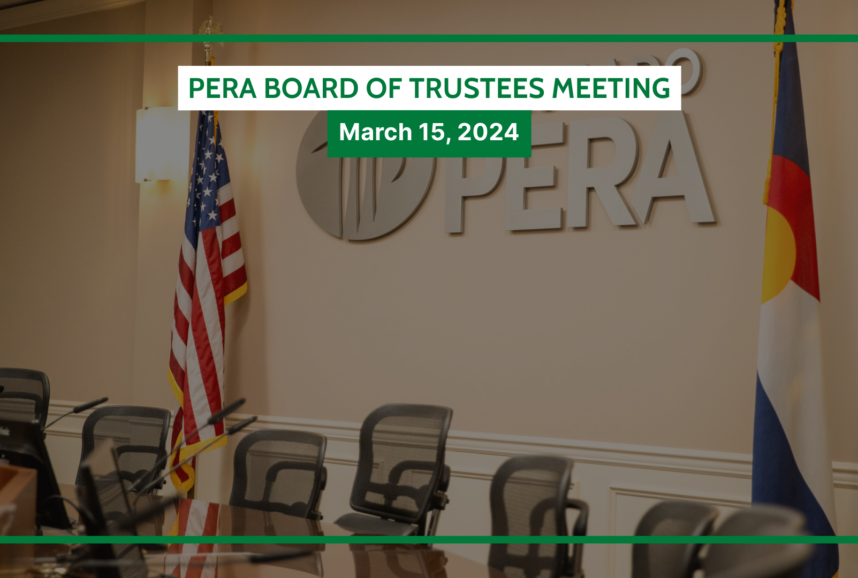On Friday, June 22, the Colorado PERA Board of Trustees announced that PERA’s funded ratio had increased to 61 percent from 58 percent as a result of changes included in Senate Bill 18-200 and 2017 investment returns. The announcement came as part of the release of PERA’s 2017 Comprehensive Annual Financial Report (CAFR).
In addition, the time-frame for reaching full funding improved significantly for each of PERA’s five divisions, dropping to 30 years or less based upon actuarial projections, while unfunded liabilities were reduced by $3.4 billion. PERA’s diversified investment portfolio returned 18.1 percent in 2017, outperforming its policy benchmark by more than 2 percent.
“With the modifications contained in SB 200, PERA will continue to provide 587,000 members and retirees with a secure benefit,” said PERA Board of Trustees Chairman Timothy M. O’Brien. “We know that the changes in SB 200 impact all segments of the PERA membership, but it is through this shared responsibility that PERA’s risk profile was significantly reduced and PERA was strengthened,” O’Brien concluded.
PERA’s annualized, net of fees, time-weighted rate of return for the last three years is 8.8 percent, the five-year return is 9.5 percent, and the 10-year return is 6.0 percent.
“While I want to recognize the strength of this year’s investment performance, it is important to remember that PERA is a long-term investor,” said Ron Baker, PERA Interim Executive Director. “Necessary changes were made to the plan to better weather the inevitable ebbs and flows of the market. The provisions of SB 200, particularly the automatic adjustment mechanism, are designed to do that,” Baker added.
Amortization Period for Each Division
| Division | Period of Time to Reach Full Funding |
| State | 27 years |
| School | 30 years |
| Local Government | 15 years |
| Judicial | 15 years |
| Denver Public Schools (DPS) | 17 years |
For an overview of the CAFR, see the PERA Financial Snapshot.
AmortizationThe act of paying down debt or liabilities over time.BenchmarkA tool used to measure performance. For example, an investor can use a stock index as a benchmark to measure his/her own investment performance compared to the market as a whole.





As inflation rises, and we retirees receive zero, and then tiny limited increases after two years, let’s see how joyous your membership is.
Related to SB 200 and when a retiree opts to cash in their sick leave which is now considered salary and subject to PERA deduction: how will this impact HAS and service credit? Could you provide an example using cashing in the maximum allowed for accrual of sick leave and half that amount and compare and contrast with how this treatment compares to cashing out maximum annual leave of 336 hours and half that (168 hours)? Thanks.
Dear Milhouse4u,
Sick leave payouts made on or after June 4, 2018 (the date the governor signed the bill into law) will be included in the Highest Average Salary calculation and subject to contributions from the member and their employer, as long as the payouts meet the eligibility criteria. Specifically, the payout has to be made pursuant to an established employer policy, at termination, and not exceed the member’s rate of pay. Additionally, the member cannot elect whether to receive the payment or when to receive the payment–this has to be included in the employer’s policy. Payouts made that meet these criteria will be spread forward to provide additional months of service credit.
Do hope that since PERA and the Legislators negatively impacted my retirement so drastically that they won’t vote raises for themselves! I am very upset with the lack of care and concert for retired people.
Jolene…the average salary of state legislature representatives (Senate and House) is $35,000 a year…..they haven’t had an increase in years. They did the best they could. The PERA board needs to make wiser decisions, cut investment fees of corporations and do proper forecasting.
We will NEVER make up the lost income after two years with no COLA. Especially since inflation is approaching double digits for by 2021. Thanks for your short sighted planning.
I fully agree that the zero and tiny increases are not joyous but down right limiting even every day living. Inflation ? Or is it recession being compared to The Great Depression ? Then what do we do?
Please stop trying to put lipstick on this pig. Fact is : Fully vested retirees have been forced to give back earned income. PERA now cannot even give a definition of “ fully-vested”.
Hope this is accurately conveyed to young teachers considering a career in which the goal post can be moved at will, even after completing a careers in good faith. Shame.
I hope PERA management will do the same to their employees they did to the retirees and not give them any raises the next two years . seems only fair.
I was very interested to participate in the “Town Hall” phone session . A call screener asked about the nature of my question, then I listened (and waited), only to hear several callers thanking PERA for SB200, and never getting to ask my question. Perhaps just coincidence, but seemed mostly pre-screened to avoid the retirees from 2000 to 2010 who, considering their age and inability to recover the loss, have really been hurt the most by the taking of vested benefits.
Our “share of the burden” was, by the very nature of the pension concept, paid up front, at a rate we had no control over, withheld and “managed” without input, then twice (since 2010) snatched away. We can only hope for, and vote towards a retro-active refund of this taking as we watch the soaring PERA rates of return continue to render insignificant the temporary downturn used to justify the 2010 theft.
Dear Ms. Thorpe,
We regret we weren’t able to have everyone who called in to the Telephone Town Hall ask their question during the call. Mr. Baker responded to a concern similar to yours about the shared responsibility approach taken by the PERA Board and then by the General Assembly that resulted in SB 200. SB 200 reduced PERA’s risk by shortening the time it will take to become fully funded. This will benefit not just the PERA membership, but taxpayers as well.
PERA Did NOT support SB 2000. Now, they are all about how are future, past, and present members are now Taken care of by the same SB. What’s up members? NO vote of confidence for members and a total cave-in to legislators which we supported. Give consideration to your vote this fall and beyond. Remember, the Statr Treasure sits on our Board of Directors.
Need to vote republican and get someone in office of State Treasurer and Governor that might care more than dictator Hickenlooper is.
Mr. Perry,
PERA employees are PERA members and will participate in all of the legislative changes contained in SB 200. They will begin contributing more in July 2019 and will have to wait three years before becoming eligible for an annual increase when they retire.
Additionally, the annual cost to administer the PERA program, as calculated by an external consultant, is $51 per PERA member and retiree.